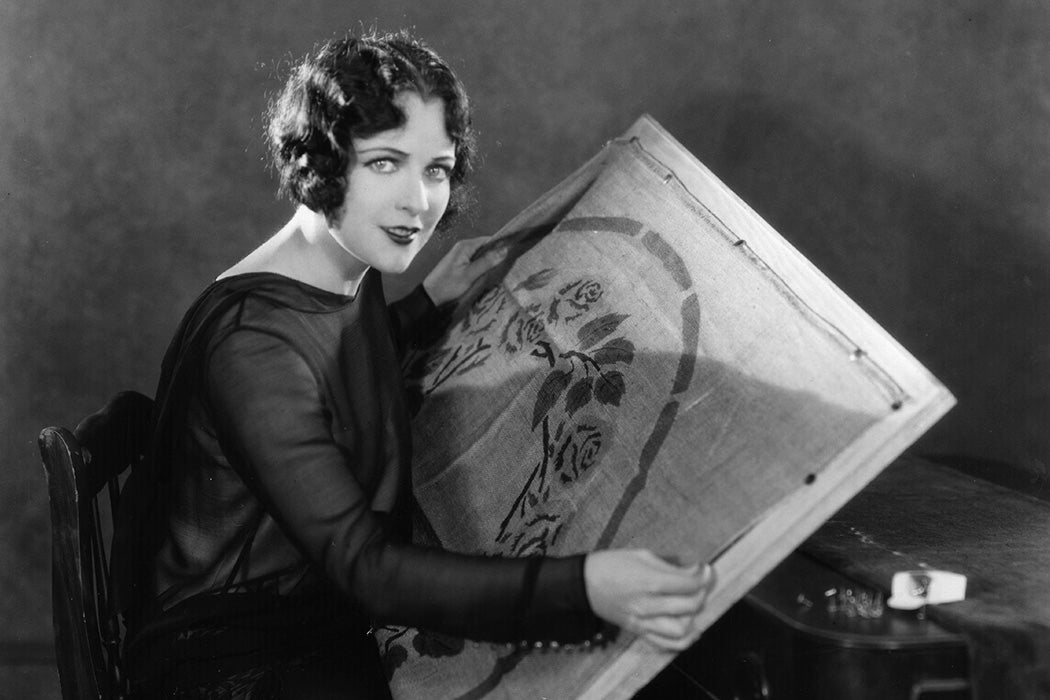Flappers, the automobile, the vote—the 1920s sizzled with possibilities for the thoroughly modern American woman. So how did she turn into a rabid consumer of olde-timey needlework? Beverly Gordon explains how the colonial aesthetic overtook American life, turning seemingly retro needlework into a must-have expression of modernity.
During the late nineteenth and early twentieth centuries, U.S. women modernized at an astonishing pace. At the same time, the burgeoning colonial revival movement made an idealized national past fashionable. The movement is thought to have been inspired by the 1876 Centennial International Exhibition, the United States’ first official world’s fair. An architectural movement ensued—but so, explains Gordon, did an interest in the decorative arts of days of yore (think spinning, crochet, rug hooking, and embroidery).
It wasn’t just about aesthetics. The movement’s rise coincided with massive immigration to the United States, and white Protestant women had a vested interest in uplifting the work of women identified with the country’s earlier days. They upheld the colonial period as a “more virtuous, noble time” and showed off their family fabric heirlooms—quilts, samplers, and the like—as proof that they had descended from “solid” stock. The supposed virtue of the colonial days intertwined with Progressivism and the Arts and Crafts Movement, says Gordon, and colonial objects and aesthetics took on a sense of heritage, moral purity, and timelessness. Progressive Era women eager to involve themselves in the community even taught poor and working-class immigrants how to do colonial-style sewing in settlement houses.
After World War I, America’s love affair with colonial needlework deepened, with an emphasis on the growing middle class. Women’s magazines popularized handcrafts as hobbies any woman could undertake, notes Gordon. “The message was that even if you did not own a quilt from your ancestors, you could make your own heirloom.” Colonial handcrafts were democratized and popularized by publications that encouraged women to sew for relaxation and fun.
As more and more women began working or going to school outside the home, colonial crafts were linked to happiness. They were also easier to do than ever, thanks to the sewing machine and simplified patterns that helped women who grew up without having to sew learn how in their leisure time. Syndicated patterns generated huge demand; Gordon notes that pattern designer Anne Orr once received half a million pattern requests on a single day. Like other aesthetic preferences of the time, colonial needlework was simplified and made more modern.
Weekly Newsletter
Though historical attention to needlework reached new heights during the era, consumers preferred the spirit of colonial design to the real thing. “To my knowledge, there were almost no commercial enterprises or individual designers who made accurate reproductions of colonial needlework in the interwar era,” Gordon writes. Old and new, needlework sold the stifling activities of the past to busy modern women, expressing the era’s ambivalence about progress.
Even as it sold old-fashioned femininity, the movement was pushed forward by savvy businesswomen who broke with that mold. “It signaled the old-fashioned, conservative, preindustrial past yet was shaped by the most modern technologies and contemporary aesthetic, social, and political forces,” concludes Gordon. Even as women bobbed their hair and shortened their skirts, it seemed, they dawdled at the door of modern womanhood, needles in hand.







